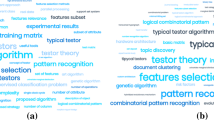Abstract
The generation of irreducible testors from a training matrix is an expensive computational process: all the algorithms reported have exponential complexity. However, for some problems there is no need to generate the entire set of irreducible testors, but only a subset of them. Several approaches have been developed for this purpose, ranging from Univariate Marginal Distribution to Genetic Algorithms. This paper introduces a parallel version of a Hill-Climbing Algorithm useful to find a subset of irreducible testors from a training matrix. This algorithm was selected because it has been one of the fastest algorithms reported in the state-of-the-art on irreducible testors. In order to efficiently store every different irreducible testor found, the algorithm incorporates a digital-search tree. Several experiments with synthetic and real data are presented in this work.













Similar content being viewed by others
Explore related subjects
Discover the latest articles, news and stories from top researchers in related subjects.References
Abbasian R, Mouhoub M (2013) A hierarchical parallel genetic approach for the graph coloring problem. Appl Intell 39:510–528
Alba E (2005) Parallel metaheuristics: a new class of algorithms. Wiley series on parallel and distributed computing. Wiley, New York
Bache K, Lichman M (2013) UCI Machine Learning Repository [http://archive.ics.uci.edu/ml]. In: School of Information and Computer. University of California Science, Irvine
Bravo A, Ruiz-Shulcloper J (1983) Algorithm MD for the elaboration of the information in pattern recognition problems. Rev Cien Mat (in Spanish) 4(1):123–132
Carrasco-Ochoa J, Martinez-Trinidad J (2004) Feature selection for natural disaster texts classification using testors. In: Proceedings of 5th International Conference on Intelligent Data Engineering and Automated Learning, LCNS 3177. Springer, Berlin Heidelberg New York, pp 424–429
Chegis I, Yablonskii A (1958) Logical methods of control of work of electric schemes. Trudy Mat Inst Steklov (in Russian) 51:270360
Dmitriev A, Zhuravlev I, Krendeliev F (1966) About mathematical principles and phenomena classification. Diskretni Analiz (in Russian) 7:3–15
Diukova E (1976) About an algorithm for constructing test. Sbornik, rabot po matematicheskoi Kibernetiki (in Russian) 1:167–185
Jensen M (2004) Helper-objetives: using multi-objetive evolutionary Algorithms for single-objetive optimization. J Math Model Algoritm 4:323–347
Kohavi R, Jhon G (1997) Wrappers for feature subset selection. Artif Intell 97:273–324
Lazo-Cortes M, Ruiz-Shulcloper J, Alba-Cabrera E (2001) An Overview of the evolution of the concept of testor. Pattern Recogn 34(4):753–762
Lopez-Perez S, Lazo-Cortes M, Estrada-Garcia H (1997) Medical electro-diagnostic using pattern recognition tools. In: Proceedings of the iberoamerican workshop on pattern recognition (TIARP 97), pp 237–244
Luke S (2013) Essentials of Metaheuristics (second edition). Lulu (available at http://cs.gmu.edu/sean/book/metaheuristics/)
Mierswa I, Michael W (2006) Information preserving multi-objective feature selection for unsupervised learning. In: Proceedings of the genetic and evolutionary computation conference. ACM Press, pp 1545–1552
Ochoa J, Valdes M, Moctezuma I, Ayala C (2008) Dimension reduction in image databases using the logical combinatorial approach. In: Innovations and advances techniques in systems. Computing sciences and software engineering. Springer, Berlin Heidelberg, pp 260–265
Ortiz-Posadas M, Martinez-Trinidad J, Ruiz-Shulcloper J (2001) A new approach to diferential diagnosis of diseases. Int J Biomed Comput 40(3):179–185
Pons-Porrata A, Ruiz-Shulcloper J, Berlanga-Llavori RA (2003) Method for the automatic summarization of topic-based clusters of documents. In: Proceedings of VIII iberoamerican conference on pattern recognition, LNCS 2905. Springer, Berlin Heidelberg , pp 596–603
Pons-Porrata A, Gil-Garcia R, Berlanga-Llavori R (2007) Using typical testors for feature selection in text categorization. In: Proceedings of XII iberoamerican conference on pattern recognition, LNCS 4756. Springer, Berlin Heidelberg, pp 643–652
Ruiz-Shulcloper J, Abidi M (2002) Logical combinatorial pattern recognition: a review. Recent Research Developments in Pattern Recognition, Transword Research Networks, Kerala, pp 133–176
Ruiz-Shulcloper J, Bravo-Martinez A, Aguila-Feros L (1985) BT and TB algorithms for calculation of all typical testors. Rev Cien Mat (in Spanish) 6(2):11–18
Ruiz-Shulcloper J, Soto A, Fuentes A (1980) A characterization of the typical testor concept in terms of a notable set of columns. Rev Cien Mat (in Spanish) 1(2):123–134
Saeys Y, Degroeve S, Van de Peer Y (2004) Digging into acceptor splice site prediction: an iterative feature selection approach. In: Proceedings of principles and practice of knowledge discovery in databases, pp 386–397
Sanchez-Diaz G, Diaz-Sanchez G, Mora-Gonzalez M, Piza-Davila I, Aguirre-Salado C, Huerta-Cuellar G, Reyes-Cardenas O, Cardenas-Tristan A. (2014) An evolutionary algorithm with acceleration operator to generate a subset of typical testors. Pattern Recogn Lett 41:34–42
Torres D, Torres A, Cuellar F, Torres M, Ponce-de-Leon E, Pinales F. (2014) Evolutionary computation in the identification of Risk Factors, Case of TRALI. Expert Syst Appl 14(18):831–840
Torres D, Torres A, Ponce-de-Leon E (2006) Genetic algorithm and typical testors in feature subset selection problem. In: Proceedings of 6th iberoamerican conference on systemics, cybernetics and informatics, pp 1–5
Valev V, Asaithambi A (2003) On computational complexity of non-reducible descriptors. In: Proceedings of the IEEE International Conference on Information Reuse and Integration, pp 208–211
Valev V, Sankur B (2004) Generalized non-reducible descriptors. Pattern Recognit 37(9):1809–1815
Valev V, Zhuravlev Y (1991) Integer-valued problems of transforming the training tables in k-valued code in pattern recognition problems. Pattern Recognit 24(4):283–288
Author information
Authors and Affiliations
Corresponding author
Rights and permissions
About this article
Cite this article
Piza-Davila, I., Sanchez-Diaz, G., Aguirre-Salado, C.A. et al. A parallel hill-climbing algorithm to generate a subset of irreducible testors. Appl Intell 42, 622–641 (2015). https://doi.org/10.1007/s10489-014-0606-1
Published:
Issue Date:
DOI: https://doi.org/10.1007/s10489-014-0606-1




